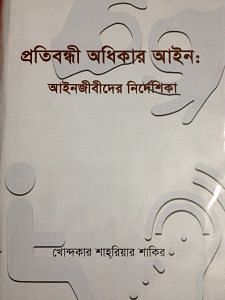Law Book Review
Respecting disability rights
Taslima Yasmin
 The disability rights movement has taken a significant place in the overall human rights activities of Bangladesh, owing to the continuous effort of the organizations working for disability rights protection throughout the last decade. As a part of such movement, Bangladesh Legal Aid and Services Trust (BLAST) has come forward with the book titled “Protibondhi Odhikar Ain: Ainjibider Nirdeshika” (“the Disability Rights Law Manual”) written by Advocate Khondoker Shahriar Shakir. It is a joint publication of BLAST and the Harvard Law School Project on Disability.
The disability rights movement has taken a significant place in the overall human rights activities of Bangladesh, owing to the continuous effort of the organizations working for disability rights protection throughout the last decade. As a part of such movement, Bangladesh Legal Aid and Services Trust (BLAST) has come forward with the book titled “Protibondhi Odhikar Ain: Ainjibider Nirdeshika” (“the Disability Rights Law Manual”) written by Advocate Khondoker Shahriar Shakir. It is a joint publication of BLAST and the Harvard Law School Project on Disability.
This book is primarily aimed to be used as a guideline by the practicing lawyers to help them effectively deal with clients with disability. This is particularly an important initiative, as persons with disability are often left with no legal remedy due to the insensitivity of the legal system towards disability rights and also due to lack of proper legal framework accommodating the special need of the people with disability. Hence, this book very rightly attempts to examine the scope for protecting the rights of the persons with disability within the existing legal framework. In doing so it has also addressed the international standard and practices relating to the disability rights.
The book commences with addressing the issue of common negative perception towards persons with disability which negatively affects their full and effective participation in society. Based on the interviews of aggrieved persons with disability in five districts, the first Chapter has identified a number of hurdles commonly faced by them, which includes among others; absence of laws with specific attention to disability rights; less accessibility to the justice system and less participation of disability rights organizations in matters relating to ensuring access to justice.
Recognising the difficulties faced by the persons with disability in accessing the justice system, the book then examines the international legal standards and best practices for the protection of such persons. Beginning with the reference to the rights ensured under the Convention on the Rights of Persons with Disability (CRPD), this chapter has discussed about a number of concepts that are used in the international arena with regard to the disability rights practice. To mention few, the concept of ensuring physical accessibility to persons with disability and their reasonable accommodation into the socio-legal structure are discussed with reference to relevant case decisions of a number of foreign jurisdictions. This discussion has paved the way for evaluating our own legal framework for protecting persons with disabilities and identifying scope for incorporating the best practices.
From the third chapter the book focuses on the domestic laws and practices and begins with listing the provisions of those laws that specifically provides for matters relating to persons with disabilities. For instance, the provisions relating to evidence of persons with mental disability and persons suffering from speech and hearing disability are mentioned in the Evidence Act of 1872. The laws listed in this chapter also include the Contract Act of 1872, the Code of Criminal procedure of 1898, Code of Civil Procedure of 1908, the Lunacy Act of 1912, the Protibondhi Kollan Ain 2001 (Disability Welfare Act of 2001) and the the Protibondhi Kollan Bidhimala 2008 (Disability Welfare Rules of 2008).
The next three chapters discuss the scope of laws and legal protection for persons with disability under Civil, Criminal and Writ jurisdictions. This is the most significant contribution of the book since these are the chapters which details the practical scope of the existing laws which has specialised provisions for persons with disability as well as the scope of the existing generalised laws and procedures and the manners in which they can be used to help persons with disability. The writer has taken a reader-friendly approach by annexing a number of model drafts at the end of the manual, for the various applications referred under the chapters relating to the three jurisdictions. This addition of draft applications is useful not only for legal practitioners but also for persons with disabilities to understand more about their own legal rights and protection.
At the end the writer has also added a chapter on how to form associations or organizations under the existing laws of Bangladesh keeping in mind the need for an institutional structure for better protection of disability rights. Another helpful feature of the manual which makes it an absolute must-have for disability rights lawyers is its compilation of the laws that are specifically required for disability rights practices. Also the inclusion of a list of appropriate words to be used for addressing persons with disabilities is noteworthy.
Above all, this manual is an excellent attempt for bringing together the disability rights practices both within and outside our own jurisdiction. Also this is a helpful guideline written in an easily understandable language to reach out those who are battling for ensuring real justice to persons with disabilities. Although evaluating the appropriateness of our legal framework is beyond the scope of the book, yet it has successfully identified the vacuums within which protection of the rights of persons with disabilities remain a challenge for the disability rights lawyers.
The writer is Senior Lecturer at the School of Law, BRAC University.